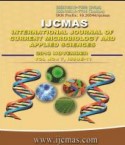


 National Academy of Agricultural Sciences (NAAS)
National Academy of Agricultural Sciences (NAAS)

|
PRINT ISSN : 2319-7692
Online ISSN : 2319-7706 Issues : 12 per year Publisher : Excellent Publishers Email : editorijcmas@gmail.com / submit@ijcmas.com Editor-in-chief: Dr.M.Prakash Index Copernicus ICV 2018: 95.39 NAAS RATING 2020: 5.38 |
The use of formaldehyde illegally in fish preservation by fishermen and fish vendors became emerging issue recently. Thus, the present study was conducted to verify the presence or absence of formaldehyde from three different retail fish markets in Mumbai. Rohu (Labeo rohita), Catla (Catla catla), Boyal (Wallago attu), Indian Mackerel (Rastrelliger kanagurta) and Bombay duck (Harpodon nehereus) were collected and tested for the presence of formaldehyde. Catla fish collected from the four Bunglows fish market contained formaldehyde conc. of 2.76 μg/g and from Andheri fish market, fish contained formaldehyde conc. of 2.88 μg/g. Rohu fish collected from Four Bunglows and Andheri fish market showed the presence of formaldehyde with 3.11 and 2.96 μg/g respectively. Boyal fish collected from Four Bunglows and Andheri fish market has formaldehyde content of 2.38 and 2.22 μg/g correspondingly. Bombay duck fish collected from the same markets contain 1.48, 1.71, 2.08 µg/g whereas Indian Mackerel fish collected were found to have 1.81, 2.27, 2.35 µg/g of formaldehyde content. Both marine and freshwater fishes were noticed to have formaldehyde content in their flesh. Even though, marine fish produces formaldehyde due to their natural process, it was lesser than the freshwater fishes probably due to adulteration in marketing chain which can be concluded through comparison with several other authors.
 |
 |
 |
 |
 |